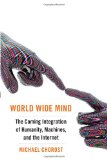
World Wide Mind: The Coming Integration of Humanity, Machines, and the Internet by Michael Chorost is published by Free Press (2011).
The title of this book is a good summary of what it’s about. It’s not about web design or web education, it’s about how the human brain could connect with other human minds through the Internet.
Chorost describes the book as a thought experiment about things that are conceptually plausible, though not yet in practice. He gives many examples of how his ideas about the future are based in technology that is already in use. There are chapters on the technology that is used to detect brain activity, chapters on nanowires and optogenetics – both mechanisms that can read and write brain activity, chapters on communications protocols for sending perceptions and memories from one brain to another, chapters on examples of what might result from linking humans to the Internet, and chapters on a possible future collective mind. The writing style is accessible and clear. In an age when people talk about neural pathways over the dinner table, the science discussions in the book are open and written for the average informed person.
Woven in with all this science reporting and speculation, is a personal narrative about Chorost’s already wired brain – he has chochlear implants. He also uses stories about his personal life and relationships to introduce concepts about how the human mind works. The book is a surprisingly easy read.
Some of Chorost’s examples are part of pop culture. He talks about The Matrix and Eternal Sunshine of the Spotless Mind, for example. He doesn’t mention Dollhouse, but I think it contains the best example of hive mind as he describes it. I don’t mean the plot line in Dollhouse where new personalities are injected into people electronically and they can suddenly be doctors or kick boxing experts. Chorost’s says that brains can’t learn that way. But there is a particular episode of Dollhouse where the character Victor is linked to a group of soldiers, who all act with awareness of what the other soldiers are doing. Yet Victor can use his own will and thinking, even while being aware of what the others he’s linked to are doing and thinking.
That Dollhouse episode is an example of Chorost’s vision of the collective awareness that would come with linking the human brain to the Internet: an awareness, a perception, but not an abandonment of one’s own thinking, one’s own self. He thinks this would be a good thing.
The ways of making that a reality involve wiring the brain with tiny wires and/or devices, or possibly using genetically modified genes that are triggered into action with light (optogenetics). The part of the process that he accepts without comment is that people would be willing to step forward and allow these things to be done to their brains. That seems like a pretty big sticking point to me.
The book has notes, a bibliography, and an index for those who want to explore in depth.
Summary: Theoretical and speculative, but fascinating.
A review by Virginia DeBolt of World Wide Mind (rating: stars)
Technorati Tags: World Wide Mind: The Coming Integration of Humanity, Machines, and the Internet, book reviews